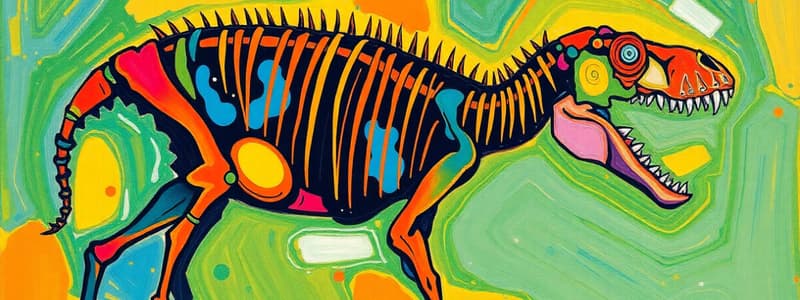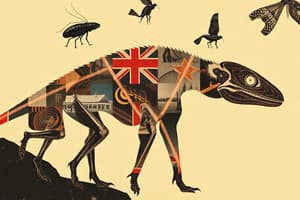Podcast
Questions and Answers
Which embryonic membrane is primarily responsible for gas exchange in amniotes?
Which embryonic membrane is primarily responsible for gas exchange in amniotes?
- Yolk sac
- Allantois
- Amnion
- Chorion (correct)
What characteristic is unique to birds compared to other reptiles?
What characteristic is unique to birds compared to other reptiles?
- Dry skin with scales
- Presence of feathers (correct)
- Ectothermic metabolism
- Multiple ovaries
Which factor contributes to the improved locomotion capacity observed in reptiles?
Which factor contributes to the improved locomotion capacity observed in reptiles?
- Behavioral temperature regulation
- Development of a thoracic cage
- Dry skin with scales (correct)
- Presence of wings
What is the primary function of the allantois in amniotic embryos?
What is the primary function of the allantois in amniotic embryos?
Which statement accurately describes the thermal regulation in reptiles?
Which statement accurately describes the thermal regulation in reptiles?
What defines invertebrates in the context of animal evolution?
What defines invertebrates in the context of animal evolution?
Which clade includes organisms characterized by the evolution of body symmetry?
Which clade includes organisms characterized by the evolution of body symmetry?
What role does the notochord play in vertebrate evolution?
What role does the notochord play in vertebrate evolution?
Which of the following innovations is associated with the clade of vertebrates?
Which of the following innovations is associated with the clade of vertebrates?
What adaptation is critical for tetrapods to successfully colonize land?
What adaptation is critical for tetrapods to successfully colonize land?
Which characteristic is NOT typically associated with exaptations?
Which characteristic is NOT typically associated with exaptations?
How do gill arches and rods evolve in vertebrates?
How do gill arches and rods evolve in vertebrates?
What is the primary mode of reproduction in ovoviviparous species?
What is the primary mode of reproduction in ovoviviparous species?
Which feature is characteristic of Osteichthyes but not present in Chondrichthyes?
Which feature is characteristic of Osteichthyes but not present in Chondrichthyes?
What is a distinguishing feature of Ray-finned bony fish (Actinopterygii)?
What is a distinguishing feature of Ray-finned bony fish (Actinopterygii)?
Which of the following statements about lobed-finned bony fish (Sarcopterygii) is true?
Which of the following statements about lobed-finned bony fish (Sarcopterygii) is true?
What is homology in the context of vertebrate teeth?
What is homology in the context of vertebrate teeth?
Which of the following is NOT a mode of reproduction in Chondrichthyes?
Which of the following is NOT a mode of reproduction in Chondrichthyes?
What adaptation allows early lobed-finned bony fish to interact with their environment?
What adaptation allows early lobed-finned bony fish to interact with their environment?
In what significant way do Osteichthyes differ from Cyclostomes?
In what significant way do Osteichthyes differ from Cyclostomes?
Which characteristic is true for most bony fish (Osteichthyes)?
Which characteristic is true for most bony fish (Osteichthyes)?
What adaptation allows Dipnoi (lungfish) to resist dry environments?
What adaptation allows Dipnoi (lungfish) to resist dry environments?
Which feature distinguishes tetrapods from their fish ancestors?
Which feature distinguishes tetrapods from their fish ancestors?
Which trait is NOT associated with the evolutionary transition of tetrapods from water to land?
Which trait is NOT associated with the evolutionary transition of tetrapods from water to land?
Tiktaalik is significant in the study of tetrapod evolution because it exhibits traits from which two groups?
Tiktaalik is significant in the study of tetrapod evolution because it exhibits traits from which two groups?
Which of the following groups of amphibians includes species that are known for their elongated bodies and lack of limbs?
Which of the following groups of amphibians includes species that are known for their elongated bodies and lack of limbs?
What environmental resources contributed to the evolution of tetrapods as they colonized land?
What environmental resources contributed to the evolution of tetrapods as they colonized land?
What is a defining characteristic of amphibian life cycles?
What is a defining characteristic of amphibian life cycles?
What primary evolutionary challenge did early tetrapods face when adapting to land?
What primary evolutionary challenge did early tetrapods face when adapting to land?
Which of the following adaptations is NOT typically associated with tetrapods?
Which of the following adaptations is NOT typically associated with tetrapods?
Which factor was least influential in the initial colonization of land by vertebrates?
Which factor was least influential in the initial colonization of land by vertebrates?
What characteristic is shared by the phyla Porifera, Ctenophora, and Cnidaria?
What characteristic is shared by the phyla Porifera, Ctenophora, and Cnidaria?
Which of the following statements accurately describes Ecdysozoa?
Which of the following statements accurately describes Ecdysozoa?
What is the primary function of the notochord in Chordata?
What is the primary function of the notochord in Chordata?
Which organism would be classified under Lophotrochozoa?
Which organism would be classified under Lophotrochozoa?
What feature distinguishes Bilateria from other animal groups?
What feature distinguishes Bilateria from other animal groups?
What defines the embryological difference of Echinodermata compared to chordates?
What defines the embryological difference of Echinodermata compared to chordates?
What anatomical feature is associated with the feeding mechanism of Cephalochordates?
What anatomical feature is associated with the feeding mechanism of Cephalochordates?
What aspect of Cnidaria's structure contributes to their locomotion?
What aspect of Cnidaria's structure contributes to their locomotion?
Which of the following is NOT true about the Acoela and Platyhelminthes?
Which of the following is NOT true about the Acoela and Platyhelminthes?
Flashcards
Invertebrate characteristics
Invertebrate characteristics
Lacking a backbone (spine).
Invertebrate classification
Invertebrate classification
Categorization based on embryological or anatomical features.
Invertebrate Phylogeny
Invertebrate Phylogeny
Evolutionary history of invertebrates.
Diversity of Invertebrates
Diversity of Invertebrates
Signup and view all the flashcards
Notochord's importance
Notochord's importance
Signup and view all the flashcards
Animal Phylogeny
Animal Phylogeny
Signup and view all the flashcards
Protostomes
Protostomes
Signup and view all the flashcards
Deuterostome vs. Protostome
Deuterostome vs. Protostome
Signup and view all the flashcards
Radial vs. Bilateral symmetry
Radial vs. Bilateral symmetry
Signup and view all the flashcards
Diploblastic vs. Triploblastic
Diploblastic vs. Triploblastic
Signup and view all the flashcards
What are coelomates?
What are coelomates?
Signup and view all the flashcards
What are Acoelomates?
What are Acoelomates?
Signup and view all the flashcards
What is Ecdysis?
What is Ecdysis?
Signup and view all the flashcards
What is a notochord?
What is a notochord?
Signup and view all the flashcards
What are pharyngeal slits?
What are pharyngeal slits?
Signup and view all the flashcards
What is the difference between a protostome and a deuterostome?
What is the difference between a protostome and a deuterostome?
Signup and view all the flashcards
Cyclostome Teeth
Cyclostome Teeth
Signup and view all the flashcards
Chondrichthyes Reproduction
Chondrichthyes Reproduction
Signup and view all the flashcards
Claspers
Claspers
Signup and view all the flashcards
Osteichthyes Bones
Osteichthyes Bones
Signup and view all the flashcards
Swim Bladder
Swim Bladder
Signup and view all the flashcards
Early Osteichthyes
Early Osteichthyes
Signup and view all the flashcards
Actinopterygii Fins
Actinopterygii Fins
Signup and view all the flashcards
Sarcopterygii Fins
Sarcopterygii Fins
Signup and view all the flashcards
Early Sarcopterygii
Early Sarcopterygii
Signup and view all the flashcards
Sarcopterygii & Walking
Sarcopterygii & Walking
Signup and view all the flashcards
Dipnoi
Dipnoi
Signup and view all the flashcards
Tetrapods
Tetrapods
Signup and view all the flashcards
New land niches
New land niches
Signup and view all the flashcards
Adaptations for land
Adaptations for land
Signup and view all the flashcards
Tiktaalik roseae
Tiktaalik roseae
Signup and view all the flashcards
Amphibians
Amphibians
Signup and view all the flashcards
Amphibian Characteristics
Amphibian Characteristics
Signup and view all the flashcards
Larval amphibian stage
Larval amphibian stage
Signup and view all the flashcards
Amphibian metamorphosis
Amphibian metamorphosis
Signup and view all the flashcards
Reasons for land colonization
Reasons for land colonization
Signup and view all the flashcards
Amniotes
Amniotes
Signup and view all the flashcards
Chorion
Chorion
Signup and view all the flashcards
Amnion
Amnion
Signup and view all the flashcards
Allantois
Allantois
Signup and view all the flashcards
Yolk sac
Yolk sac
Signup and view all the flashcards
Study Notes
Topic 13: The Evolution of Animals II
- Learning Outcomes: Define key characteristics of invertebrates, classify invertebrate organisms, place the evolution of body symmetry on a phylogeny, justify the importance of the notochord in vertebrate evolution, organize key vertebrate innovations on a phylogeny, describe gill arch and rod evolution, explain early tetrapod adaptations for land colonization, classify tetrapod adaptations, and define exaptations.
Animal Phylogeny
-
Invertebrates: Make up 95% of known animal species. Invertebrate organisms are paraphyletic. They lack a backbone (spine).
-
Animal Phylogeny Diagram: Shows relationships among different animal groups, such as porifera, cnidaria, and bilateria. Also includes echinodermata. Shows evolutionary lineages and common ancestors.
Invertebrates
- Porifera (Sponges): Diploblastic, radially symmetrical, sessile, lack true tissues.
- Ctenophora (Comb Jellies): Diploblastic, radially symmetrical, have a nervous system.
- Cnidaria (Jellyfish, Corals): Diploblastic, radially symmetrical, sessile polyps and swimming medusae, hydrostatic skeleton.
- Bilateria: Bilateral symmetry, triploblasty (mesoderm), digestive tube develops from the blastopore, some have a coelom (body cavity). Includes acoela and platyhelminthes (lack a coelom and digestive tract), and lophotrochozoa (with lophophore or trochophore larval stage). Also includes ecdysozoa that periodically molt their exoskeleton (cuticle).
- Lophotrochozoa: Some have a lophophore (crown of tentacles for feeding) or a trochophore larva. Examples include brachiopods and mollusks.
- Echinodermata: Bilateral symmetry (larval stages), have a water vascular system for locomotion, feeding, respiration, and excretion.
- Ecdysozoa: Protostomes with an exoskeleton.
Chordata (530 million years ago)
- Key Characteristics: Notochord (longitudinal, flexible rod), dorsal hollow nerve chord, pharyngeal slits. post-anal tail.
- Notochord: Key innovation that enabled muscle attachment for locomotion.
Vertebrates
- Cyclostomes (Jawless Vertebrates): Lack jaws.
- Gnathostomes (Jawed Vertebrates): Modification of gill arches creates jaws, increased complexity from two rods to multiple.
Chondrichthyes (Cartilaginous Fishes)
- Characteristics: Cartilaginous skeleton, placoid scales, internal fertilization.
Osteichthyes (Bony Fishes)
- Characteristics: Bony skeleton, swim bladder for buoyancy, internal skeleton to which muscles attach.
Dipnoi (Lungfish)
- Characteristics: Functional lungs, adaptation for dry environments.
Tetrapods
- Characteristics: Four limbs with digits, adaptations for land life, support against gravity, breathing in air, hearing in air.
- Early Tetrapod Traits : Development of limbs with digits and ribs.
- Amphibians: Aquatic larval stage with gills, metamorphosis to terrestrial form, loss of tail.
- Amniotes: Amniotic egg protecting embryo from desiccation.
Reptiles
- Characteristics: Dry skin with scales, ectothermic, improved locomotion. Evolved from amphibians.
Birds
- Characteristics: Feathers as an adaptation for temperature regulation, courtship, protection, and later flight. Evolved from dinosaurs.
Mammals
- Characteristics: Mammary glands, endothermy, larger forebrain, differentiated teeth, hair and fat layers. Evolved from reptiles.
Primates
- Characteristics: Opposable thumbs for grasping, large brains, social behaviours.
- Hominids: Bipedal locomotion, reduced jaws, short digestive tract. Language.
Humans
- Characteristics: Bipedalism, reduced jaw bones, short digestive tract, complex language and symbolic thought, advanced tool use.
Studying That Suits You
Use AI to generate personalized quizzes and flashcards to suit your learning preferences.
Related Documents
Description
This quiz explores the evolution of invertebrates and key characteristics such as body symmetry and the notochord's significance in vertebrate evolution. It also covers phylogenetic relationships among various animal groups. Test your understanding of animal phylogeny and early adaptations of tetrapods for land colonization.




